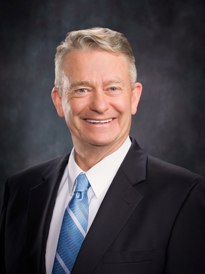Brad Little Wins Majority Support in Largest Idaho GOP Gubernatorial Field
Little has now defeated more candidates in gubernatorial primaries than any Idahoan in state history

With nearly 95 percent of the vote counted, Little is enjoying a 20-point lead with 52.8 percent of the vote with McGeachin at 32.3 percent and leading in only the four northernmost of the state’s 44 counties.
Voter support for Little is comparable to that received during the reelection bids of his predecessor, Butch Otter, who won 54.6 percent in 2010 and 51.4 percent in 2014.
Little, however, did so against the backdrop of the largest ever Idaho Republican gubernatorial field and the largest number of challengers during a governor’s reelection bid by either party in state history.
A total of eight candidates were on the GOP ballot on Tuesday, though only one other hopeful earned double-digit support – financial advisor Ed Humphreys (11 percent). No other candidate received more than two percent of the vote.
The previous record number of Republican contenders for the party’s nomination for governor was set during the previous cycle when Little won a seven-candidate field with 37.3 percent, narrowly defeating former U.S. Representative Raul Labrador.
That means Little now holds the all-time Idaho record of defeating 13 candidates in gubernatorial primaries. Otter defeated 11 candidates across his three primary victories.
By comparison, four-term Democratic governor Cecil Andrus defeated only two primary candidates (running unopposed three times), and three-time nominee C. Ben Ross beat a total of five candidates during his 1932, 1934, and 1938 campaigns. Three-time GOP nominees C.A. Bottolfsen (1938, 1940, 1942) and Robert Smylie (1954, 1958, 1962) had to dispense with just four challengers each.
The most challengers an incumbent governor from either party in Idaho had previously faced was the five who ran against Otter in 2010.
The eight-candidate GOP field ties a state record for the largest number of gubernatorial hopefuls on a primary ballot.
The open seat race for governor in 1936 saw eight Democrats vie for their party’s nomination with Idaho Falls Mayor Barzilla Clark winning with just 17.4 percent of the vote with six challengers trailing by single digits including runner-up and Attorney General Bert Miller with 17.0 percent.
Tuesday’s primary was the 32nd for the office in state history. [The primary era is inclusive of the cycles from 1910-1918 and 1932 to the present. For six cycles, from 1920 through 1930, both major parties selected their nominees via state conventions.]
Little will face Democratic educator Stephen Heidt – who was nominated without opposition – in the general election.
Follow Smart Politics on Twitter.

JANICE McGeachin ~
Since the Republicans have won the post, almost always lopsidedly, from 1994 onwards, perhaps it is no wonder that the party would host such a large field for this and 2018 cycles.
1936: One might think that after the top two contenders together have only garnered a sliver more than 1/3 of the vote, an ‘instant runoff voting’ would be adopted – unless the state constitution specifically prohibited it.
I am curious if the 17.4 percent won by B. Clark in ’36 is the lowest support ever garnered in gubernatorial primary for states w/out run-offs?
This contest was also a rare governor vs. lieutenant governor primary matchup, only the second in a quarter century.
In the states where the two offices are elected separately (including Idaho), general election matchups between a governor of one party and a lieutenant governor of the other party are not unheard of. In 2020, for instance, governors Roy Cooper (D-N.C.) and Phil Scott (R-Vt.) turned back challenges from lieutenant governors Dan Forest (R-N.C.) and David Zuckerman (Prog./D-Vt.), respectively. And in Idaho, Gov. Cecil Andrus (D) defeated Lt. Gov. Jack Murphy (R) in 1974 and Gov. John V. Evans (D) defeated Lt. Gov. Phil Batt (R) in 1982. Other examples I could find are Colorado in 1966 and 1970, Ohio in 1978, Vermont in 1982 and 1986, North Carolina in 1988, Alabama in 1998 and 2006, and Georgia and Rhode Island in 2006. [In 1972, Lt. Gov. Paul Simon (D-Ill.) was slated to challenge Gov. Richard Ogilvie (R-Ill.) but was upset in the primary by Dan Walker; lieutenant governors attempting to unseat their governors also failed to win their party’s nomination in Kansas in 1972, Iowa in 1986 and 1990, Vermont in 1996, and New York in 1998.]
As for primary matchups between governor and lieutenant governor, I found a roughly equal number as the general election matchups above but these seem to be less common in recent years. Lt. Gov. Francis Bellotti (D-Mass.) defeated Gov. Endicott Peabody (D-Mass.) in the 1964 primary, and Lt. Gov. Ted Schwinden (D-Mont.) defeated Gov. Thomas Lee Judge (D-Mont.) in the 1980 primary. In Hawaii, Gov. John A. Burns defeated Lt. Gov. Thomas Gill in the 1970 Democratic primary, and Gov. George Ariyoshi defeated Lt. Gov. Jean King in the 1982 Democratic primary, both by single-digit margins. In Texas, Lt. Gov. Ben Barnes and Gov. Preston Smith placed third and fourth, respectively, in the 1972 Democratic primary. Other examples I could find are Minnesota in 1966, Vermont in 1970, Florda and South Dakota in 1974, Connecticut and New York in 1978, Massachusetts in 1982 [the lieutenant governor ran but withdrew before the primary], New Mexico in 1994, and South Carolina in 2018.
At the federal level, Vice President John Nance Garner famously challenged FDR for the Democratic nomination in 1940. As well, former Vice President (and ex-President) Theodore Roosevelt challenged President William Howard Taft throughout 1912 (both halves of the year). And then in 2024…a matchup involving a former president and a former vice president?